The purpose of this blog is to provide a centrally supported space to capture and share digital education practice from across King’s College London. It’s a community contribution blog for individual and teams working in this area and provides an opportunity to promote initiatives to a broader audience, both internally at King’s and externally across the sector. Continue reading “Welcome to the Digital Education Blog”
Redesigning KEATS
Leading with UX: How we reimagined KEATS for 2025
KEATS, King’s College London’s virtual learning environment, plays a central role in teaching and learning across the institution. While it undergoes regular technical updates – such as Moodle version upgrades, security patches, and minor interface adjustment – recent years have seen a growing emphasis on improving its visual design and alignment with the King’s brand.
The release of Moodle 4 in 2023 provided an opportunity to refresh the platform’s interface, resulting in a cleaner, more modern look and a stronger visual identity. However, due to the scale of the redesign and tight delivery timelines, there was limited scope for user involvement or data validation during that phase.
By 2025, with a more established visual identity in place, the focus shifted toward enhancing the user experience (UX) for students and staff. This phase prioritised functionality, usability, and user-centred improvements – moving beyond aesthetics to ensure the platform better supports everyday use.
A UX-led approach (on a tight deadline)
At the request of Digital Education, the UX team at King’s Digital led a six-week initiative to plan, test, and implement meaningful changes to KEATS. The approach was lean, data-informed, and highly collaborative.
The team conducted a rapid discovery phase, drawing on:
- Findings from previous usability testing
- Results from the System Usability Scale (SUS) survey
- Informal interviews with students and staff
These insights highlighted key areas where small, targeted improvements could significantly enhance the user experience.
Cross-functional UX workshops brought together designers, researchers, developers, and stakeholders to:
- Prioritise changes based on impact and feasibility
- Clarify the rationale behind each proposed improvement
- Define a realistic scope for a one-month delivery window
What we changed (and why it mattered)
Here’s what we delivered and how user feedback shaped every decision.
1. Top Menu:clarity through card sorting
Challenge: Students reported difficulty locating key information, and the top menu occupied excessive screen space when scrolling.

Solution: A card-sorting exercise informed a redesigned top menu with clearer labels, reduced height, and improved responsiveness. The result is a more intuitive navigation experience that enhances content discoverability.

2. Dashboard: prioritising key tasks
Challenge: Usage data revealed that the dashboard experience lacked clarity and focus, with several competing elements diluting its effectiveness. In particular, the Timeline feature – especially important on mobile – was under-emphasised and not as accessible as it could be.
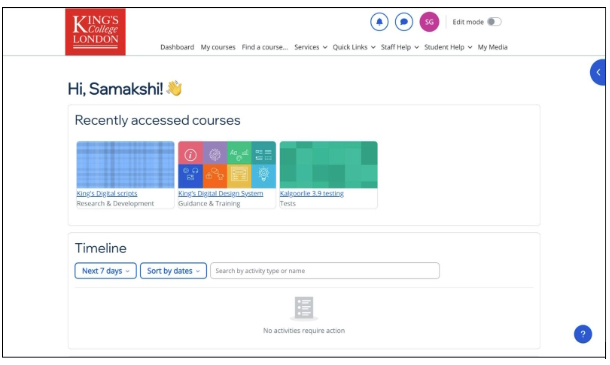
Solution: Through three design iterations, the dashboard was simplified, the Timeline was elevated in prominence, and visual hierarchy was improved. These changes support a more task-focused experience for students.

3. Custom Section course format: consistency for focus
Challenge: Inconsistent course formats and reliance on unsupported plug-ins created usability and maintenance challenges.

Solution: The Moodle-native Custom Sections format was restyled to align with institutional design guidelines. This enables consistent use across KEATS, supporting a more cohesive and accessible learning experience.

The Impact
Despite the ambitious timeline, the initiative delivered measurable improvements:
- Positive sentiment quadrupled in usability testing
- 100% of students in guerrilla testing rated the new dashboard as “good” or “excellent”
- Users described the platform as “cleaner,” “more modern,” and “easier to navigate,” particularly on mobile devices
These enhancements, while incremental, had a meaningful impact on the overall user experience.
Looking ahead
This project laid the groundwork for a longer-term UX strategy for KEATS. A dedicated Product Designer has now joined the team to embed user-centred design practices into ongoing development. Continuous iteration, informed by regular feedback, will guide future improvements.
The next SUS survey will provide further insights into user needs and preferences. Staff and students are encouraged to participate and help shape the future of KEATS.
Final thoughts
KEATS 2025 represents more than a visual update – it marks a shift toward proactive, user-led development. By prioritising usability and aligning design with real user needs, King’s is taking meaningful steps toward delivering a better digital learning experience.
🙋♀️ Want to chat more about UX in education or share your KEATS experience?
Our next Coffee & UX ☕ event is on 6th November (9am to 12pm), and we’re inviting both presenters and participants of the wider community to join us at King’s. If you’re interested in UX in Education — whether to share, learn, or just chat over coffee — we’d love to see you there.
More information and sign-up can be found at this website.
About the author
Juliana Matos, UX Manager at King’s College London | Experienced LXer | Bridging academia, education, and industry through thoughtful, data-driven, human-centred UX strategy.
Reframing AI in Higher Education: From Hype to Practice at King’s Foundations
Introduction
Artificial Intelligence (AI) is no longer just a hot topic it’s a reality rapidly shaping how we design, deliver, and reflect on education. While discussions around AI are increasingly open and active across King’s College London, the pace and tone within King’s Foundations has been more reserved.
As a Learning Technologist working in King’s Foundations, I recently attended the Association for Learning Technology’s (ALT) OER25 Open Education Conference. This experience sharpened my perspective on how AI, particularly generative AI can be critically and constructively embedded across not just assessment and feedback, but curriculum design, staff development, and internal communication. The key? Moving beyond automation and embracing openness, collaboration, and shared ownership.
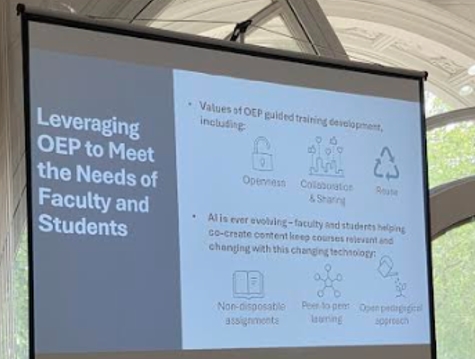
Artificial Intelligence
At OER25, one of the most recurring themes was that AI reveals not resolves, the tensions already embedded in our educational systems. A speaker from the AI Now Institute urged participants to ask not how much AI we can use, but how little computational power we need to retain meaningful educational practice. This principle, dubbed “frugal computing,” flips the narrative from efficiency to intentionality.

This resonates deeply with our current challenge in King’s Foundations. While there have been informal discussions around AI mostly centred on resource development, assessment redesign, and feedback workflows conversations often occur in silos. During the conference, examples from other institutions showed that siloed experimentation without shared resources or policy scaffolding often leads to duplication, inconsistency, and missed opportunities.
Many departments at King’s (outside of Foundations) are engaging in visible pilots such as AI-supported assessment banks, ethical guidelines, even student training hubs. But internally, staff across King’s Foundations may only hear about innovations from other teams through casual conversations or ad hoc meetings. This presents a major gap: not just in practice, but in strategic alignment.
Lessons learnt
1. AI Should Be Seen as a Shared Resource, Not a Specialist Tool
From feedback generation to curriculum scaffolding and even budgeting, AI has potential across a broad spectrum of educational activity. The open MOOC (Massive Open Online Course) case study from Politecnico di Milano highlighted how modular, editable resources shared across departments helped create consistent student experience while reducing duplication of effort. King’s Foundations has the potential to lead in creating a shared AI resource hub supporting consistency, reducing duplication, and promoting inclusive, informed digital practice across teams.
2. AI Can Reduce Feedback Inequality but Only with Transparent Practice
The OER25 sessions addressed hidden labour and opacity in AI use. For King’s Foundations, AI-generated feedback could help reduce marking load and give students quicker responses. But unless these systems are transparent, explained, and ethically disclosed, students may distrust them, or staff may avoid using them.
There’s also an opportunity to explore shared, open banks of feedback phrases and models making formative feedback not just fast, but open and peer reviewed. This would also facilitate more aligned feedback standards across King’s Foundations courses, helping reduce the “black box” nature of academic comments.
3. Internal Communication is as Important as Innovation
One standout comment at the conference came from a digital education researcher who said:
“Most departments don’t need new AI tools they need shared language and shared direction.”
King’s Foundations has a strong culture of innovation but often lacks systematic ways of sharing outcomes and learnings. AI pilot projects such as using co-pilot agents for formative feedback, AI summarisation of reading packs, or tools like Explainpaper for decoding complex texts and Perplexity for guided research should be openly documented, evaluated, and scaled. A regular ‘AI in Practice’ forum could promote transparency and reflect the open sharing ethos reinforced at OER25.
4. Open Educational Practices (OEP) Must Include AI Transparency
The conference raised deep concerns around AI disrupting knowledge equity. From data scraping of open archives to the invisible labour of data labellers, generative AI often operates in ethically grey spaces. For King’s Foundations has a unique opportunity to lead by embedding discussions of AI literacy, openness, and creative commons licensing into our professional development and curriculum.
By modelling these practices internally, For King’s Foundations can support not only better teaching but clearer communication, values alignment, and trust-building with students and staff alike.
The way forward
To move forward, AI must be treated not as a technical upgrade, but as a cultural shift that demands openness, reflection, and collective action.

Recommendations
- Create a shared digital repository of AI-assisted tools, templates, feedback prompts, and ethical use cases across KF that are easily accessible and clearly communicated to all staff. Ensure that resources are well-organised, regularly updated, and supported by clear guidance on how to access them, who to contact for further information, and where to go for training or troubleshooting. This will help eliminate confusion, raise awareness, and promote confident, consistent use across teams.
- Facilitate regular cross-departmental check-ins (e.g. AI in Practice sessions) to surface, connect, and align AI-related initiatives.
- Pilot AI feedback enhancements in a transparent, student-informed way, ideally within formative assessment stages first.
- Develop a King’s Foundations-wide AI policy primer, aligned with King’s broader policies, including OER and open pedagogy principles.
There is an opportunity not only to align with the wider college conversation on AI, but to help shape it through critical practice, grounded experimentation, and visible collaboration.
Useful Links
- OER25 Conference – Association for Learning Technology (ALT)
- AI Now Institute – “Artificial Power” Report
- Creative Commons
& AI Policy
About the author
Faith Namakula, Learning Technologist at King’s Foundations with a sharp focus on digital transformation, AI-enhanced education, and strategic innovation in assessment and feedback. Faith specialises in bridging technology and pedagogy, enabling data-informed, compliant, and effective digital practices that align with King’s strategic priorities. With expertise in project delivery, stakeholder engagement, and digital capability development, she is committed to embedding sustainable, high-impact solutions that contribute to institutional excellence and sector-leading practice.
Coffee & UX ☕, brewing change in higher education
Designing better learning experiences – one cup at a time.
User Experience, or UX, can make or break an online product. Ever tried tapping a tiny button to add an event to your calendar, only to blame the size of your finger and, in frustration, end up messaging your partner to remind you instead? You’re not alone. Giving up on your calendar perfectly illustrates the statistics: according a report by RMG Digital, 90% of users will leave a website because of poor design. And you’ll be glad to hear that this experience doesn’t just frustrate users – it also hurts businesses. In fact, according to the same report, 70% of online businesses fail due to bad UX.
While UX might seem like a hot topic today, its principles have been around for over 30 years, though they are often misunderstood or misapplied. The term itself was coined in the 1990s by Don Norman, one of the founders of the influential Nielsen Norman Group, to describe everything a person feels and experiences when interacting with a product or service.
As the Nielsen Norman Group explains:
The first requirement for an exemplary user experience is to meet the exact needs of the customer, without fuss or bother. Next comes simplicity and elegance that produce products that are a joy to own, a joy to use. True user experience goes far beyond giving customers what they say they want, or providing checklist features. View the Nielsen Group article.
Simply put, when UX is done well, it feels almost invisible, helping people get what they need without frustration or hassle. When it’s done badly… it’s very noticeable.
UX for EdTech presents a particular problem. The stakes are quite different – it’s not just about user-friendly tools, or a nice interface, but about creating meaningful learning experiences that truly support students throughout a transformative educational journey. Without strong design and UX, even the most innovative and academically sound educational technology can fall flat – and that can be a real problem when students are already facing the (enormous!) cognitive challenge of learning something new. Providing these great experiences means going beyond usability to include engagement, motivation, and effective learning outcomes – a broader approach often encompassed by the term ‘LX’.
While commercial providers of educational technology have been grappling with UX for some time, with varying degrees of success, in higher education, UX is still a relatively new concept, with its own set of challenges. The rapidly changing world, evolving digital experiences, growing competition, and rising student expectations all add layers of complexity. Combine that with academic rigour, complex systems, and diverse student needs, and designing genuinely student-centred experiences becomes a real balancing act.
I was aware of these challenges as I stepped into the role of UX Manager at King’s, yet undeterred. Coming from a background in teaching and private EdTech, I saw this role as a chance to bring everything I’d learned into a new environment with its own rhythms, ecosystems, and rewards. And it’s been great to see my team bridge that gap hosting events such as UXDX, as well as by participating in MUGGL and ALT M25.
That said, some challenges here at KCL still felt strangely familiar, only on a much larger scale. In the higher education sector, silo mentality inhibits communication between institutions but often within them too, leaving departments keen to find opportunities yet uncertain of how and where to share insights or best practices. It quickly became clear to me that although incredible work was happening across the organisation and within the wider EdTech industry, its full impact was held back by a lack of connection and collaboration. What was missing was a dedicated space to focus specifically on UX for EdTech – which is exactly why KCL’s Coffee & UX ☕ began.
KCL’s Coffee & UX ☕ is a simple idea with a clear purpose: to connect, create a community of practice, spark conversation, and bring a bit of change into how we think about and design for students. It’s much more than a platform to showcase our work; it’s a welcoming space that encourages open conversation, shared learning, and collaboration, helping the incredible work happening across the organisation reach its full potential.
The premise is simple: once a quarter, we gather on a King’s campus in central London for a couple of hours, with coffee and snacks. Each team shares what they’ve been working on, and together we explore the tools, methods, and approaches shaping our work. We discuss research findings, share challenges and wins, and exchange best practices. It’s also a chance to get to know each other, build connections across departments, and spark ideas for improving the student experience – whether that involves digital learning tools, physical spaces, workflows, or blended experiences that bridge both.
So far, we’ve held two meetings: one in spring and one in summer. From the very first session, it was clear we had something special – the excitement and positive feedback were overwhelming. Teams connected, shared ideas, discussed best practices, and explored ways to collaborate. The conversation didn’t end there; our group chat continued buzzing with reflections, questions, and action points, showing just how engaged everyone was. It was a real sign that Coffee & UX ☕ was creating a space people value and want to keep building.
The summer edition, held on 10th July, was another great success, with over 10 attendees from King’s Digital’s UX team and Quality Assurance Officers; Libraries & Collections; Digital Humanities; IT; and Student Knowledge Info & Enquiries. With a sharper focus this time, teams shared specific projects sparked by our first meeting, such as the assessment templates research and the development of a research repository. We also explored new topics, including databases in PowerBI, card sorting exercises to organise the VLE’s top menu, accessibility research, and inspiring examples of how libraries are pushing UX further to meet students where they are. It was truly inspiring to see such a diverse range of work underway and to feel the strong passion for enhancing the student experience across King’s. To close, and as a testament to how valuable we’ve found these meetings so far, we discussed opportunities to enhance our ongoing efforts to build a real community, including a proposed calendar of activities moving forward.
So, what’s next for KCL’s Coffee & UX ☕? Our goal is to open the door wider – to welcome more teams from across King’s to share, collaborate, and tackle the unique challenges we face together. We also want to expand our circle by inviting colleagues from other universities to join the conversation, sparking fresh ideas and new partnerships. Ultimately, we’re aiming to bridge gaps – within our institution, between universities, and between higher education and the EdTech private sector, building a vibrant, connected community that drives real, positive change for students.
Do any of these challenges or ideas resonate with you? Have you tried something similar in your institution or organisation? Maybe you’ve faced similar hurdles in your own institution, or you’re simply curious about how we’re shaping the User Experience landscape in Higher Education and want to get involved? Whether you’re interested in sharing your experiences, asking questions, or just having a friendly chat about UX and the student experience, I’d love to hear from you. Let’s connect, learn from each other; and maybe explore how we can make a real difference together… over a cup of coffee?
Our next event is on 6th November, and we’re inviting both presenters and participants of the wider community to join us at King’s. If you’re interested in UX in Education -whether to share, learn, or just chat over coffee – we’d love to see you there.
About you the author
Juliana Matos, UX Manager at King’s College London | Experienced LXer | Bridging academia, education, and industry through thoughtful, data-driven, human-centred UX strategy.
DigAcc25: A Day of Digital Accessibility at King’s
Introduction
DigAcc25 is a digital accessibility conference that brings together professionals from across the UK Higher Education sector. Since its launch in 2023, the University of Nottingham has hosted DigAcc annually. This year’s event took a distributed approach where institutions were encouraged to host local events.
We joined in the fun at King’s College London and I organised a local event where we could watch the conference together. On 25 June 2025, around 30 colleagues from across King’s (including teams from Digital Education, IT, and EDI) came together at Waterloo campus for a day dedicated to digital accessibility. Colleagues may or may not have been influenced by the promise of pastries and lunch…! Thank you to Brickfield Education Labs for supplying some freebies for the day, including digital accessibility cubes (pictured later). Each side featured a handy reminder for tips on improving accessibility.

Why bring DigAcc25 to King’s?
Whilst King’s doesn’t yet have a dedicated digital accessibility team, there are many colleagues and teams doing great work in their own areas. What’s currently missing is a space to bring those efforts together, which what I hoped DigAcc25 would help kickstart.
In my role as a faculty Technology Enhanced Learning Manager, I have been advocating for digital accessibility in my faculty. This includes raising awareness through empathy–focused activities, delivering training for both academic and professional services staff, and carrying out audits on our virtual learning environment (VLE). When undertaking accessibility work, it is not unusual to feel isolated without a wider network to exchange ideas or seek advice. Hosting a local DigAcc25 event was a way to bring people together, start conversations, and hopefully bring about changes!

Lunchtime networking
Although we were working within the structure of the DigAcc programme, I made space for a King’s-only lunchtime session by shortening the scheduled 1 hour 40 minute lunch break. Potentially a risky move, but one that I think paid off! With nourishment provided by King’s Food, colleagues remained fuelled up!
The lunchtime session featured five quick-fire presentations and gave a flavour of what colleagues across King’s are working on:
- I kicked things off with a quick overview of the work the Technology Enhanced Learning (TEL) team has been doing in The Dickson Poon School of Law, and posed a question to the room about the European Accessibility Act, which came into force on 28 June 2025.
- Fiona Strawbridge (Director of Digital Education) set the scene on where digital accessibility currently stands at King’s and encouraged everyone to share ideas from the day.
- Alistair McWiggan (Curriculum and Digital Innovation) gave a demo of the work he’s doing to create accessible courses and resources on the distance learning programmes and mobile-responsiveness for the Institute of Psychiatry, Psychology & Neuroscience (IoPPN).
- Jemma Adams (EDI Manager – Disability Inclusion) introduced everyone to the work their team does, and reminded us that digital accessibility is just as important for staff as it is for students.
- Dan O’Meara (Digital Education Manager) shared insights from a recent VLE audit for the Faculty of Natural, Mathematical and Engineering Sciences (NMES) and walked us through the results.

Highlights
For me, the highlight of the day was sharing a space with colleagues where digital accessibility was at the heart of the agenda. It was refreshing to be surrounded by colleagues who care about making our digital spaces at King’s more inclusive.
Talks that stood out to me included sessions on how to bring accessibility into procurement processes and how other institutions have involved neurodivergent and disabled students in their VLE testing. I also appreciated talks on how emotional connection can help people understand why digital accessibility matters, and hearing how other institutions have approached accessibility audits. These latter areas are things we’ve been working on in my faculty, so it was encouraging to know we’re on the right track.
I gathered feedback after our local event to hear what people’s highlights were. A majority of those who responded said they valued the chance to connect with others working on similar accessibility challenges. One colleague shared:
- “It was great to connect with peers and think through different approaches and ways to tackle what can sometimes seem like an insurmountable challenge. And the recognition that we are all working on this, together, is very heartening.”
Others highlighted the value of the lunchtime event and the chance to hear from and network with King’s colleagues:
- “I enjoyed the lunchtime talks the most, as it was wonderful to hear what my colleagues at King’s were doing to improve the accessibility of our online resources and workplace!”
- “Definitely the networking element and the lunch talks … it was so great to get a better idea of the people engaged in digital accessibility in King’s and what this looks like in this context.”

What’s next for digital accessibility at King’s?
The main takeaway is that we need more time and space to come together, share ideas, and keep the momentum going. Event planning isn’t my forté but I’m glad King’s colleagues were keen to be involved and make the event a success.
As a result of DigAcc25, I’m setting up a digital accessibility community at King’s. This will be a space where anyone with an interest in digital accessibility can share resources, ask questions, and hopefully learn from each other. Get in touch if you’d like to be part of it!
The feedback from the day also included suggestions for incorporating accessibility into life at King’s. These ideas will be shared with senior leadership, and I hope we can shift from working in our silos to a more joined up approach. As quoted from the DigAcc25 “Welcome”, it’s time for us to become “collective voices instead of individual advocates”. Watch this space!
Thank to you to the DigAcc25 team at The University of Nottingham for putting the conference together and to all the colleagues at King’s who joined our local event.
About you the author
Clare Thompson is the Technology Enhanced Learning Manager for The Dickson Poon School of Law, King’s College London.

KEATS Upgrade: 22 July 2025
KEATS will be upgraded to Moodle 4.5.5 on Tuesday 22 July 2025. As part of this upgrade KEATS will be placed into Maintenance Mode and unavailable to staff and students between 06:00-14:00 (UK Time).
This upgrade introduces enhanced search options, visual improvements and new assessment functionality for staff and students.

Enhancements include:
- The introduction of a personalised search function enabling you to search for content within courses you are enrolled in.
- An improved navigation via the introduction of a consistent top menu.
- A cleaner and streamlined KEATS Dashboard, providing a task focussed view of courses and alerts for students.
- Better visual design and usability for users accessing KEATS via mobile devices.
- An improved assignment interface, introducing sticky headers and footers, improved filters and bulk actions.
- Automated notifications to students for deadlines for upcoming assignments and quiz submissions.
- Quicker access to ‘starred’ courses directly from your top menu.
- The maintenance of a secure and accessible platform compliant with modern standards.
Please note, faculties and departments use KEATS in different ways and may have different templates and approaches for you to be aware of. If you are in the middle of teaching during this upgrade and are experiencing unexpected changes, please do contact your Programme Team in the first instance and log any issues via 88888@kcl.ac.uk.
We apologise for any inconvenience caused during this important upgrade.
Digital Badges and Certificates at King’s Business School
Overview
In today’s fast-paced and ever-evolving world, professional development is essential. King’s Business School (KBS) is taking steps to stay ahead of the curve by introducing Digital Badges and Certificates—a modern way to represent and recognise achievements and skills. These credentials provide students and staff alike with verified proof of their accomplishments, which can be easily shared on platforms such as LinkedIn or added to digital portfolios.
What Are Digital Badges and Certificates?
Digital badges are visual representations of skills, achievements, or credentials earned through formal and informal learning experiences. They serve as verifiable indicators of one’s accomplishments, making it easier for individuals to showcase their expertise to employers and institutions.
Why Are Digital Credentials Important?
Digital badges come with a range of benefits that traditional recognition methods, such as printed certificates, cannot provide. Each badge includes metadata that verifies:
- The issuer of the badge.
- The criteria needed to earn it.
- Evidence of the achievement.
Additionally, digital credentials are easily shareable across social media platforms and digital storage, providing greater portability and visibility. They also enable faster and more cost-effective distribution, making them an efficient alternative to traditional certificates.
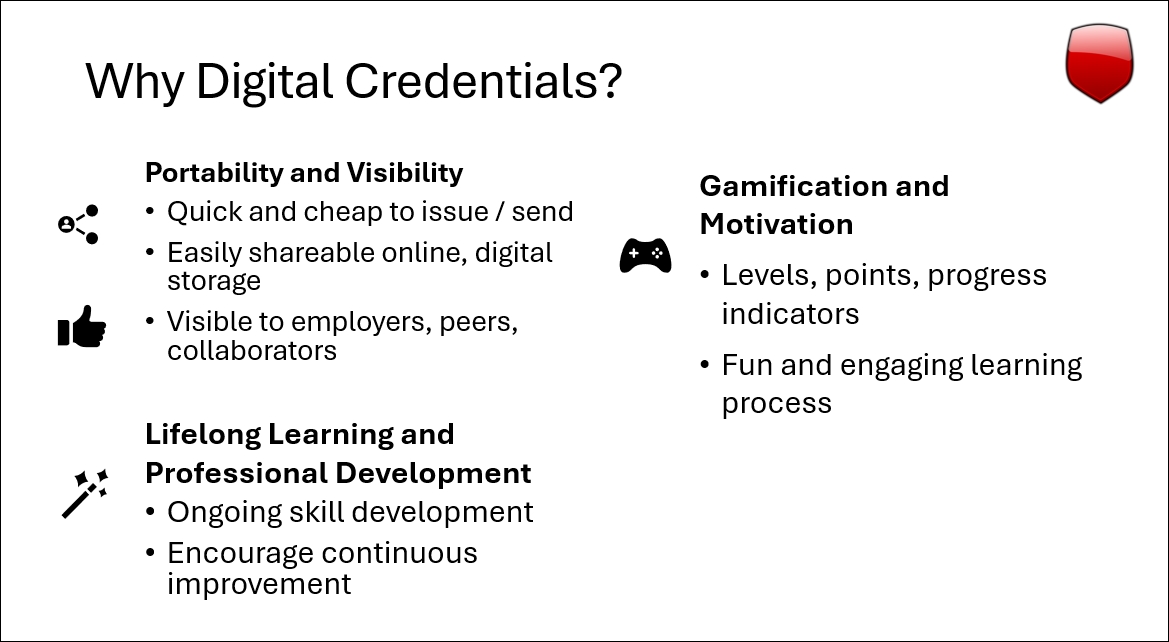
Enhancing the Learning Experience at KBS
At KBS, the integration of digital credentials supports the school’s commitment to fostering lifelong learning. It encourages continuous professional development and offers students an engaging learning process through elements of gamification – such as levels, points, and progress indicators – that make skill development fun and motivating.
KBS’s Digital Credentials Initiative
The launch of digital badges was initially supported as a 12-month pilot by the KBS Innovative Education Fund Bid, with the main goal of enhancing alumni engagement, student experience, and employability. Collaborating with various teams across KBS, the project aims to formally recognise career development and help foster a sense of accomplishment.
Key uses include:
- Recognising peer tutors and student representatives.
- Showcasing teamwork and leadership skills to prospective employers.
- Highlighting achievements in modules such as the IMPACT program, increasing the visibility and prestige of KBS students.
The Accredible Platform
The backbone of this initiative is the Accredible platform, a system that allows for the creation, issuance, and sharing of digital credentials. KBS invested £7,660 into the platform to provide digital badges for up to 1,000 recipients. This includes the cost of the platform itself (£7,030) and graphic design services (£630) to ensure that each badge meets the KBS brand standards.
Lessons Learned and Next Steps
The introduction of digital badges has not been without challenges. Coordinating the design process, ensuring brand compliance, and understanding the platform’s features required collaboration across various teams. Despite this, the feedback has been positive, and the initiative has already begun making a difference in student engagement and employability.
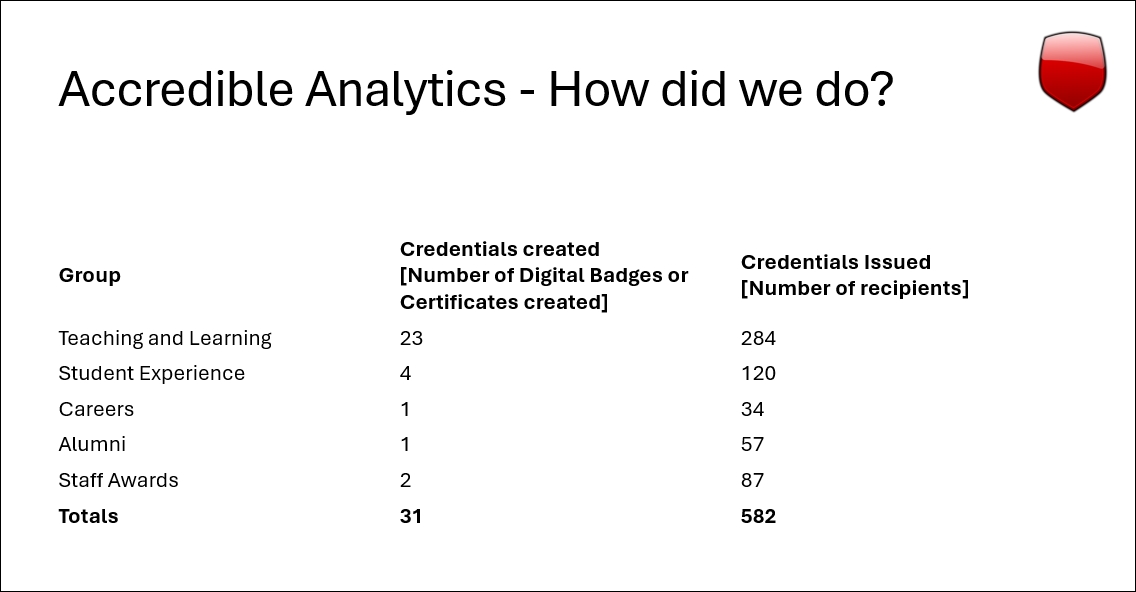
Looking forward, KBS have renewed use of the platform for the new academic year, continuing to issue badges and expand their use within the school. We plan to assess the review the use of the platform by the end of 2024-25 and determine its future role in KBS’s Digital Education strategy.
About the Author

Alastair Gemmill is Digital Education Manager at King’s Business School, King’s College London
Analysing Student Engagement with KEATS and Academic Performance
Summary
In this post, we describe the research presented at the King’s Education Conference 2024, which focused on the impact of student engagement with KEATS on academic performance.
The Story
Motivation
Virtual Learning Environments like KEATS offer students convenient and flexible access to course materials. Engaging with these platforms requires a deliberate investment of time and effort from students, with the potential rewards of significantly enhancing their academic performance. Therefore, understanding this relationship is essential for creating effective online learning environments that promote student success. Our study aimed to investigate how the total hours students spent on KEATS correlates with their final exam grades.
Study Context
Our research focused on a one-year mathematics foundation module at King’s Foundation during the 2022-2023 academic year. This module followed a blended learning approach, combining online and face-to-face components. The study involved 238 students, aged 17 to 20, from different nationalities and educational backgrounds. The students were required to spend 2 hours each week on KEATS, engaging with instructional videos, practice problems, and exercises, while also attending weekly seminars and live lectures in person.
Data Collection
We analysed two main datasets: KEATS engagement data and student performance data. The KEATS engagement data included total time spent online, and the performance data consisted of grades from various summative assessments, including the final exam.
The Outcomes
Exploratory Data Analysis
We first used descriptive statistics and visualizations to assess the data. The scatter plot below suggested a linear relationship between time spent on KEATS and final exam grade, indicating that students who spent more time on KEATS generally achieved higher grades. Interestingly, the plot also revealed an empty area in the bottom right corner, showing that no students with high engagement had low final exam grades.
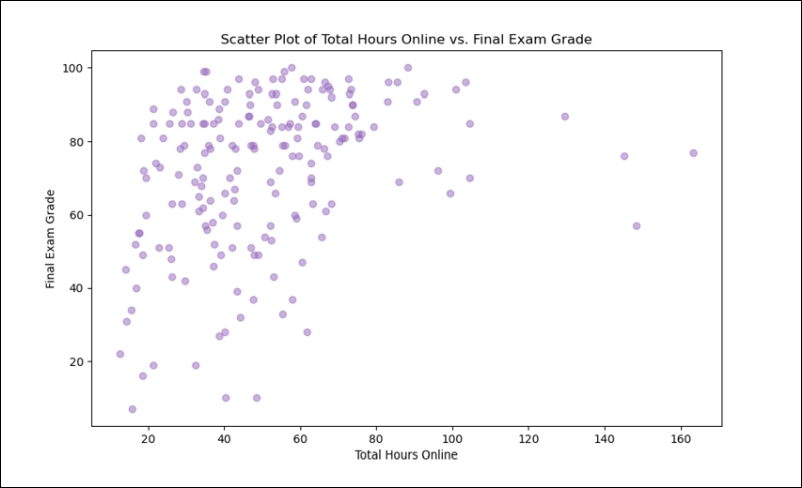
Identifying Patterns
Next, we categorized engagement into quartiles and found that students with higher engagement levels consistently achieved better final exam grades, as shown in the boxplots below. The analysis strongly suggests that lower engagement with KEATS is associated with lower grades and that this pattern is unlikely to be coincidental.
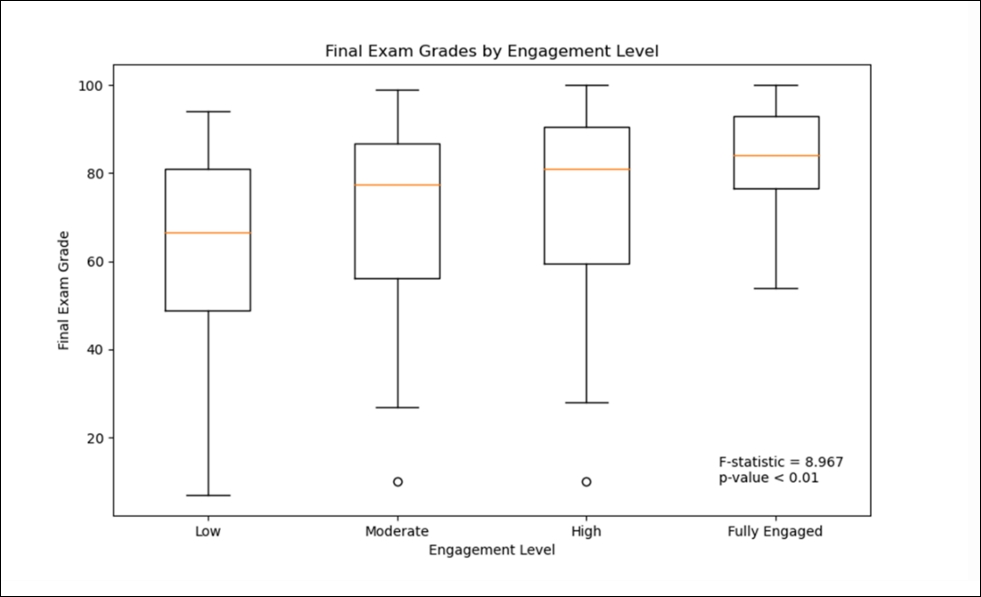
Correlation and Regression Analysis
Finally, the Pearson correlation coefficient revealed a moderate positive relationship between KEATS engagement and final exam grades (r=0.33). To further investigate this relationship, we used multiple linear regression models. The best model, which included all summative tests and total hours online, explained 39% of the variance in final exam grades. This model suggests that each additional hour spent on KEATS was associated with an increase of approximately 0.2 percentage points in the final exam grade.
Conclusion & Recommendations
Our study indicates that increased interaction with KEATS leads to better academic outcomes. The results of this analysis can inform the development of targeted strategies to support all students, promoting a more inclusive and effective learning environment.
Educational Implications
Based on our findings, we recommend the following actions:
- Encourage active participation in KEATS to enhance academic performance. Tools like the KEATS Course Participation Report can send targeted messages and reminders to boost engagement.
- Identify students needing additional support by analysing KEATS data and implementing timely interventions.
- Monitor KEATS usage and assessment results regularly to track student progress and tailor pedagogical approaches.
We hope this blog provides valuable insights into the importance of student engagement with KEATS. For any questions or further discussion, please feel free to contact me at eleonora.pinto_de_moura@kcl.ac.uk
Technical Note
The data analysis was conducted in Python, using libraries such as pandas for data manipulation, matplotlib and seaborn for data visualization, and statsmodels for statistical modelling.
Useful Links
- KEATS Course Participation Report
- Python Libraries for Data Analysis
- Data Visualization in Python using Matplotlib and Seaborn
Intended Audience
Educators, Academic Researchers, Learning Technologists and Administrators.
About the Author
 My name is Eleonora Pinto de Moura, and I’m a Lecturer in Mathematics Education at King’s Foundations. My research interests include educational technology, data-driven teaching strategies, and enhancing student engagement through innovative learning digital tools.
My name is Eleonora Pinto de Moura, and I’m a Lecturer in Mathematics Education at King’s Foundations. My research interests include educational technology, data-driven teaching strategies, and enhancing student engagement through innovative learning digital tools.
Facilitating Groups Assessments on KEATS
Introduction
Increasingly, modules are diversifying their assessment types and branching out into group assessments instead of essays and other more traditional assignments. As Professional Services, we want to support this in our schools and departments wherever possible, without it adding further administrative burden or creating scope for error. The goal was to facilitate students submitting assessments in groups whilst also enabling module leads and students to get the most out of other functions in KEATS which groups allow, such as group forums, restricting content by group, and creating marking groups for markers. In other words, we wanted a smooth experience for students submitting their assessments, whilst also enabling module leads and contributors to utilise the full extent of KEATS and maximise student engagement.
The Challenge
Previously, students would be a member of only one group within a module page to keep things “simpler”, which unfortunately restricted how students and staff could engage with KEATS. Alternatively, we have kept manual records of student groups and submissions which added additional administrative burden. Neither of these solutions were the ideal we were looking for, so we decided to turn our attention to the underused groupings feature on KEATS. We knew from experience that the settings in groupings must be set up exactly or students may be prevented from submitting or submit in the wrong group. Therefore, the challenge was to learn how to set up the settings on KEATS to interact with different activities successfully. Whilst it was an investment in time and resources at the beginning to work out how groupings operate, I was hopeful that it would streamline things going forward and create a better student and staff experience.
The process commenced with an initial consultation with the SSPP TEL team. I learned that the “groupings” functions as a group of groups and different activities on KEATS could be set up to pull groups from specific groupings. For example, there may be several presentation groups within a module which could all be included in the umbrella group presentation grouping. The Moodle assignment activity associated with this group presentation could then be set up to pull groups directly from the group presentation grouping, hereby avoiding the confusion of potentially pulling the groups from the seminar groups or forum groups instead. The team set me up with a sandbox on KEATS, effectively a practice area, where I could set up the journey that a student would take.
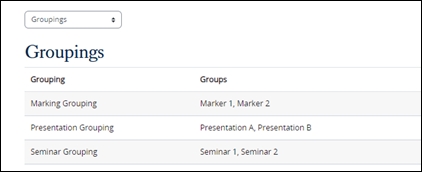
The three main things I wished to test were:
- signing up to a group via the Group Choice Activity
- being added to other groups in different groupings,
- submitting as part of a group to see if all ran smoothly.
I replicated the settings on this practice page, following SSPP TEL guidance on groups and groupings, and I enlisted my very patient and enthusiastic Professional Service colleagues from ECS to be enrolled as students on the practice page, asking them to take the journey of the students. When colleagues submitted their mock assessments, the groups were pulled from the correct assessment groups grouping. As I had selected the settings that allowed one student to upload on behalf of all their group members on the Moodle assignment activity, when one group member submitted, the correct group members were also populated with their group’s submission. It appeared the testing showed everything to go to plan and there was no scrambling of submissions. I was in the clear to replicate these settings throughout the module pages where there were group assessments.
The Outcomes/ Lessons Learnt
Outside of the specific details of how to technically set up the various activities, I learned to think holistically about the KEATS pages and always consider how one setting or action might affect and interact with other activities or areas of the page. It’s also underpinned how crucial the initial set up of activities and course pages are, so going forward, I’d always advise plenty of time and, of course, meticulous checking of these settings in advance of busy times such as submission deadlines.
Conclusion/ Recommendations
In conclusion, I’d strongly advise my colleagues, not to be scared of groupings and groups! Yes, they require careful set up, but once up and running, they enable us to utilise a variety of activities and functions on KEATS, increasing interaction and, minimising administration in the long term whilst maximising engagement for students.
Written By Joanne Devenney
Senior Programme Officer
School of Education, Communication and Society
Giving Recorded Audio Feedback is Easy!
Introduction
In the Law Faculty, we trialed providing recorded audio feedback for formative assessments in Contract Law. The result? Of the 91 students who had received either recorded audio feedback or written feedback for their assessments, 66% preferred recorded audio feedback. 3 of the 4 staff members who responded to our survey also preferred providing recorded audio feedback.
Why?
The NSS score for “Assessment and Feedback” at KCL remains stubbornly low at 68%. With the growing body of literature which extols the virtues of recorded audio feedback, we decided to see if it works for Law. We also wanted to investigate the effect it has on students with particular specific learning difficulties.
How?
The Technology
The platform which we used for providing feedback was the Assignment Tool through KEATS (Moodle). Turnitin also has an audio feedback tool but this only allows for three minutes of feedback to be recorded which felt unnecessarily restrictive.
The Law School Professional Services team set up the Assignment Tool submission link on KEATS. They also created a drop-down menu which allowed for grouping of the students by tutorial group. The Law TEL team created bespoke guidance for the teaching team on using the chosen technologies.
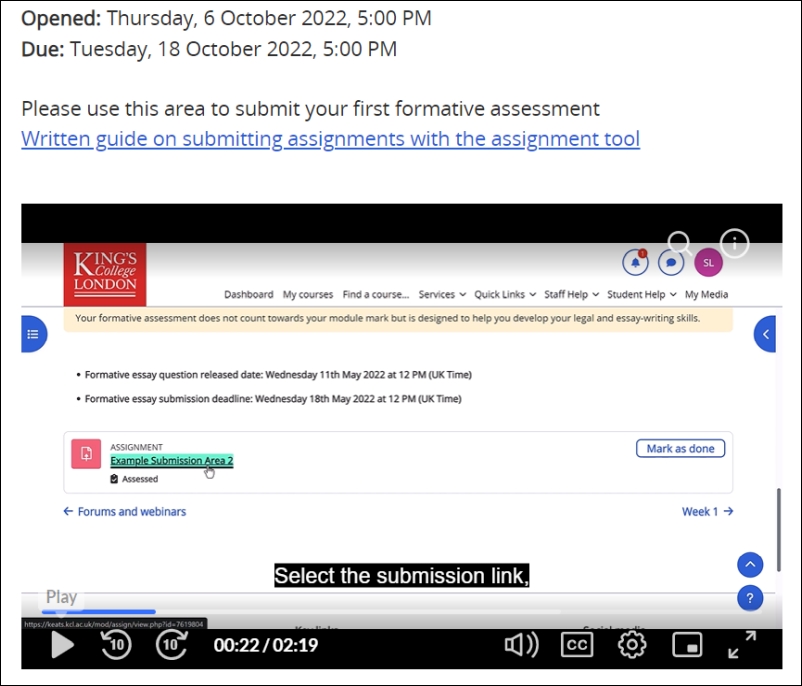
The student submission process was almost identical to the standard Turnitin submission process and we doubt whether many of the students even noticed the difference.
We used Kaltura Express Capture to provide the feedback. This was easy to use (although it was reported by tutors that in order to record the feedback it did necessitate rather a lot of “click throughs”).

The Feedback Process
In our instructions to students, we requested that they number the paragraphs in their submission to make it easier for us to refer verbally to specific points in their answers.
In our training for markers, we suggested that the feedback should be between 3 and 5 minutes long. We suggested the following structure to markers:
- Start with some general positive feedback about the answer.
- Identify some specific areas for improvement. It is really important that you explain how they can improve rather than just pointing out what has gone wrong.
- Identify specific things which they have done well. (These could obviously be intertwined with the specific areas for improvement above).
- Please finish on some really positive things about the answer. Whilst it is important for students to have some specific ways in which they can improve, students should come away from this experience feeling encouraged.
- In terms of the language which should be used, when you are pointing out some of the negative things, please do not use the second person e.g. “You did not explain this area very clearly.” Instead, use language such as: “It would have been better if the answer explained this area more clearly.” It is preferable not to pin the negative aspects on students personally.
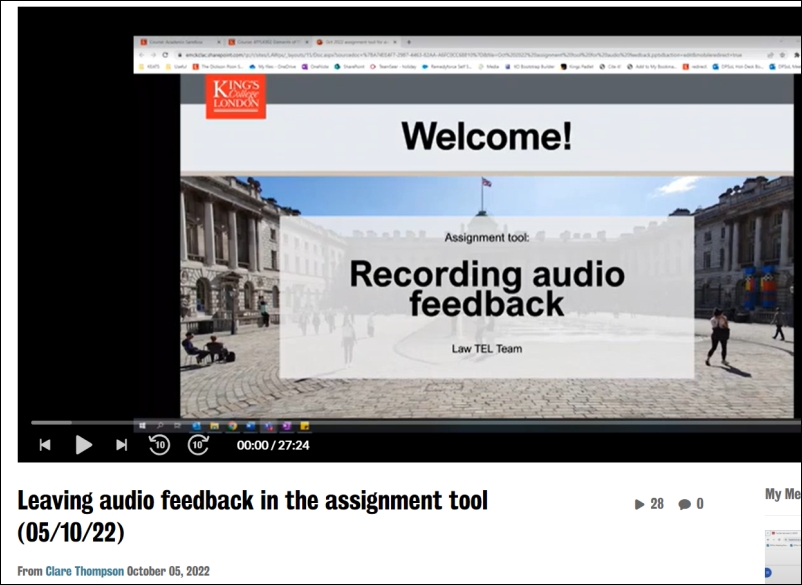
The Student Survey
Students completed three pieces of formative work for Contract Law. Students either received written feedback, recorded audio feedback or a combination of recorded audio feedback with a few comments on the paper. We only surveyed those students who had received recorded audio feedback or recorded audio feedback with some comments written on the paper for at least one formative assessment (i.e. we did not survey those students who had only received written feedback).
We were interested in finding out about the experience of students with a specific learning difficulty. Consequently, in our survey we asked whether students had been diagnosed with or suspected they may have: dyslexia, dyscalculia, dyspraxia, dysgraphia or attention deficit hyperactivity disorder.
Student Survey Results
Recorded Audio Feedback versus Written Feedback:
- 91 students (out of a cohort of approximately 250) responded who had received recorded audio feedback for at least one assessment and who had not experienced the combination of recorded audio feedback and written feedback.
- 60 preferred recorded audio feedback.
- 31 preferred written feedback.
5 of these students had been diagnosed / suspected they have a specific learning difficulty. Of these 5, 4 preferred recorded audio feedback and 1 preferred written feedback.
Recorded Audio Feedback versus a combination of Recorded Audio Feedback and Written Feedback or Written Feedback on its own:
16 students received a combination of recorded audio feedback and written feedback for at least 1 assessment.
- 10 preferred the combination.
- 1 preferred recorded audio feedback.
- 5 preferred written feedback.
5 of these students had been diagnosed / suspected they have a specific learning difficulty. Of these 5, 2 preferred the combination and 3 preferred written feedback.
Staff Survey
4 members of staff (out of a team of 7 colleagues with marking responsibilities on the module who provided recorded audio feedback) responded to the survey. Of those, 3 of the 4 preferred providing recorded audio feedback and 1 preferred providing written feedback. None of the 4 members of staff who responded to the survey had provided a combination of recorded audio feedback with a few comments on the paper.
Technology Gripes
Whilst the tech served the desired purpose, there are a number of ways in which it could be stream-lined. If the following issues with the technology were resolved, this would make the process much easier for staff:
- Leaving audio feedback with Kaltura Express Capture requires an irritating number of clicks.
- You cannot pause Kaltura Express Capture (e.g. if you lose your train of thought.)
- Captions are not switched on automatically. This means that each tutor has to click on each piece of feedback to turn them on.
- The Assignment Tool does not allow the feedback to be set to be released automatically on a certain date in advance. Although it can all be released in one batch, you have manually to release it by clicking a button (not a big issue but you need to put a note in the diary to remember!)
- Obtaining viewing analytics is not as streamlined as Turnitin’s audio feedback feature and requires manually going through each video on Kaltura.
The Outcomes / Lessons Learnt
When given the choice between recorded audio feedback and written feedback, the majority of students prefer recorded audio feedback. The most common 5 reasons they gave were:
- I felt that it was more personal.
- I felt that the explanations were easier to understand;
- It was helpful to hear the tone of my tutor’s voice;
- The volume (i.e. amount) of feedback was greater.
- The process of receiving recorded audio feedback is more active than receiving written feedback.
In terms of students with specific learning difficulties, the majority of these students also preferred audio feedback to written feedback.
When given the choice between recorded audio feedback, written feedback or recorded audio feedback with some comments written on the paper, students preferred the combination. (Please note, however, that the sample of students who were given the combination was very small and it was only 1 tutor who provided this method of feedback.)
However, students reporting specific learning difficulties did not favour combined audio and written feedback. Given the option, the preference for them was a return to the familiarity of purely written feedback. It may have been that the combination of both feedback formats made it more challenging for the students with specific learning difficulties to interpret the key take-home message(s) from the feedback. Thus, the combined approach, rather than clarifying or supporting the comments made, actually muddied the waters.
When it came to staff, the most common reasons why the three staff members preferred providing recorded audio feedback to written feedback were as follows:
- I found it faster to provide recorded audio feedback.
- I felt that it was more personal.
- I felt that my explanations were easier to understand.
- I liked the fact that the students could hear the tone of my voice.
- I thought that the process of students receiving recorded audio feedback was more active than receiving written feedback.
Conclusion / Recommendations
The commentary from our students and their clear preference for audio feedback supports current pedagogical research regarding the benefits of recording audio feedback above traditional written feedback, such as the perception amongst our students that the feedback experience is richer and more personal. We know from Caruthers et al (2015) that this leads students to be more likely to engage with their feedback. Also, the perception that feedback was both greater in volume yet easier to understand supports Chaing’s (2009) claim that audio feedback provides a greater depth to feedback in comparison to uncontextualized written feedback comments.
Though our overall cohort of students who declared a specific learning difficulty was admittedly small in our data set, it was still interesting to see that these students experienced recorded audio feedback in a more positive way than compared with their past feedback experiences. Though it is clear that for these students particularly, a mixed approach to feedback (i.e. providing a combination of both audio and written feedback) should be avoided.
Overall, colleagues’ experience of providing audio feedback was positive and once familiar with the recording process and given clear support on how to format their audio feedback (including the appropriate length for such feedback to ensure consistency amongst markers), colleagues were able to leave (according to our students) greater volumes of clear, individualized, meaningful feedback. We would, therefore, recommend that other colleagues who have not yet provided audio feedback to their students try the medium as our experience has been, overall, extremely positive from both a student and staff perspective.
Useful Links
About The Authors
Caroline van Hensbergen is a Senior Lecturer in Law (Education) at the Dickson Poon School of Law, King’s College London.
Dr Michelle Johnson is a Lecturer in Law (Education) and Faculty Inclusive Education Lead at the Dickson Poon School of Law, King’s College London.
KEATS Upgrade: 16 July 2024
KEATS will be upgraded to Moodle 4.4.1 on Tuesday 16 July 2024. As part of this upgrade KEATS will be placed into Maintenance Mode and unavailable to staff and students between 06:00-16:00 (UK Time).
This upgrade introduces several enhancements focused on refining the user interface and making it easier to edit your KEATS pages.
Check back on the blog after upgrade for a video highlighting upgraded features.

Enhancements include:
- Activity icons have been updated with an accessible colour palette.
- You can now quickly create content by clicking on a plus icon anywhere on your main KEATS page.
- Text and media areas now include a ‘name’ field, which appear in the course index on the left of your page.
- When using the grader report, you can now search, collapse columns and view feedback directly on the grader report page.
- For those using group forums, you can now easily post to all groups with the ‘Post a copy to all groups’ option available directly underneath your forum post.
- The Tiny MCE editor has been improved and is now the default editor, featuring a full-screen button for an enhanced editing experience.
- Bulk actions such as deleting, moving, duplicating, hiding, or changing visibility can now be performed directly from the footer.
- The edit menu now allows you to easily change availability options and group modes.
- Lastly, you can now copy H5P activities in the content bank to adapt them, making content creation more flexible.
Please note, faculties and departments use KEATS in different ways and may have different templates and approaches for you to be aware of. If you are in the middle of teaching during this upgrade and are experiencing unexpected changes, please do contact your Programme Team in the first instance.

